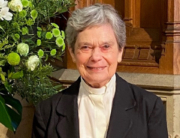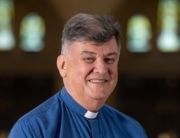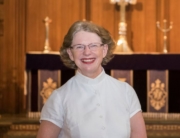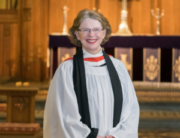Preacher: The Very Rev’d Frank Nelson
Psalm 106: 42 – 50
Isaiah 58: 9b – 14
Luke 2: 22 – 40
Verse 8 of chapter 1 in the book of Revelation, the last book in the bible, reads: “I am the Alpha and the Omega, says the Lord God, who is and who was and who is to come, the Almighty.” Alpha and Omega, the first and last letters of the Greek alphabet, became code for Jesus Christ. In Christian iconography the Alpha (like a capital ‘A’) is usually superimposed on Omega (a little bit like a croquet hoop, or an upside-down ‘O’ with the bottom cut off). Look carefully at almost any church and somewhere, in a window, on the embroidery, perhaps even on the communion wafer, you will find this symbol.
It’s a good reminder to us that God, in Jesus Christ, is the beginning and the end, and everything in between. But, of course, it is not only the Alpha Omega symbol that brings this idea to our attention. A reading such as we heard tonight from Luke chapter 2 has a similar function. Tonight we heard how Mary and Joseph brought the infant Baby Jesus to the Temple in Jerusalem – there is the beginning. In the Temple they are met by two very old people – Simeon and Anna. Both faithful to God, both have, in a sense, been waiting for this moment. In this short story we have the beginning of one life, that of Jesus, and the imminent ending of two lives, that of Simeon and Anna.
As a priest I have been struck at how often I am called to officiate at a funeral in the same week as I am called to give thanks for the birth of a child. There is something rather wonderful about that. And Alpha and Omega speak to that – the beginning and the end, ‘who is and who was and who is to come’. So it has been this weekend. Yesterday I visited someone who is dying, as Jenny and Leonie did this afternoon; and this morning I was talking to a young couple who are expecting the birth of their first child this week. It can be something of a roller coaster – to go from the sadness, the serenity, the sense of this being the last conversation, to that almost impossible-to-contain sense of excitement mixed with apprehension that comes with the imminent birth of one’s own first child.
It is such a natural thing to notice and to do – this coupling of birth and death.
The Feast of the Presentation of Christ in the Temple, celebrated on 2nd February, is the opportunity par excellence to notice this. Forty days after Christmas Day St Luke tells us that Mary and Joseph took Jesus to the Temple.
As with so many of our Christian festivals the exact origins are lost in the mists of history. Luke tells us that Mary and Joseph were being obedient to the Law of Moses in going to the Temple. For them it was both a time of giving thanks for the birth of their child, and giving thanks for the safety of the mother in child-birth. In the Book of Common Prayer there is a service known as ‘the Churching of Women” – closely linked with the idea of another name for the Presentation – the Purification of Mary. The ancient Romans had a ceremony for women who had given birth. They would light candles and walk through the streets showing their neighbours that they had come safely through the trials of child-birth and inviting them to join them in thanksgiving. Candlemas is another very very old name for this festival on 2nd February – with no prizes for guessing its origin. Some churches encourage people to bring candles to church on that day, where they are blessed and then kept to be used through the year. (Not unlike our Port Sunday in November when wine is brought to be used for Communion during the year.)
Long before Augustine went to Canterbury at the end of the 6th century and established the Roman Church in England, the Celtic Church had a strong presence throughout Britain – especially in Ireland and Wales. The pre-Christian Irish marked 2nd February as an important farming day in their calendar. Mid-way between the shortest day of the year, the winter solstice, and the spring equinox on 21 March, this day was called Imbolc (Imbolg). It marked the first day of spring when the ewes began to show signs that the lambs would soon be born. It was a sign of new life, of coming out of the dark days of winter and hibernation – a sort of annual death. The ancient Celtic goddess of fertility, Bride or Brigid, was worshipped on this day. Christians promptly baptised Bride and called her Bridget. The name stuck and Bridget became one of the best known Irish saints, second only to Patrick.
According to legend Bridget did many of the things Jesus himself did – teaching, healing, casting out demons, even raising the dead. I particularly like the story of her changing water, not into wine (which was unknown in Ireland at the time) but into beer! Her biographer, Cogitotus, records that “this venerable Bridget was asked by some lepers for beer, but she had none. She noticed water that had been prepared for baths. She blessed it, in the goodness of her abiding faith, and transformed it into the best beer, which she drew copiously for the thirsty. It was indeed He who turned water into wine in Cana of Galilee who turned water into beer here, through this most blessed woman’s faith!” Well, I don’t know, but it’s a good story. And if it leads us to give thanks to God for the bounty we enjoy – why not?
We’ve drifted rather a long way from Jesus being presented in the Temple – but perhaps not? For our faith in God is rooted in the stuff of life – and that means both birth and death, water and beer. It is our privilege and responsibility as members of this Cathedral, as members of the Cathedral Choir, to sing the praises of God, including the Song of Simeon, the Nunc Dimittis. The old man Simeon recognised that as his death approaches a new era was beginning. It is a time when the light of God will enlighten the whole world – even the Gentiles. It is a magnificent death poem – looking to the future with hope and trust. It is a poem, or canticle, which should be said or sung, and often is, at the funeral of every Christian person.
As we sing the Nunc Dimittis week by week, may we continually hold in God’s sight those places in the world where darkness prevails, and those who are approaching death, and those who are about to bring new life into the world.
Lord, now lettest thou thy servant depart in peace according to thy word.
For mine eyes have seen thy salvation,
Which thou hast prepared before the face of all people;
To be a light to lighten the Gentiles and to be the glory of thy people Israel.




